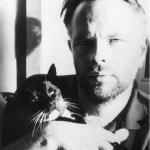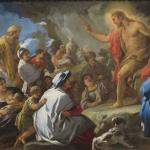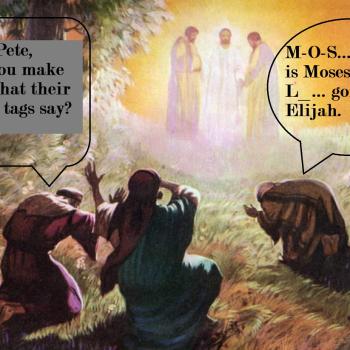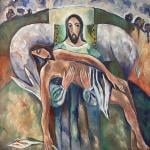As promised, here is my blog post about Michel Faber’s novel, The Book of Strange New Things. I listened to it as an audiobook, allowing me to finally get to it after having had it recommended to me by several people. For anyone who enjoyed Mary Doria Russell’s The Sparrow, this is similar inasmuch as it focuses on extraterrestrial mission work and theodicy, but also very different beyond that in terms of its plot, its overall feel, and the way it broaches the theological, emotional, and interpersonal matters its characters wrestle with.
The episode starts by giving us a glimpse of the relationship of a couple about to undergo a rather unique and extreme sort of challenge. Many relationships cope for periods of separation by long distances. None in human history in the time of we who are reading this novel have involved one spouse traveling to another world as a missionary, leaving the other behind on Earth. In the time in which the novel is set, this is a rather unique circumstance as well.
Since the book is about an interplanetary missionary, there is obviously theology, religion, spirituality, and related matters woven all throughout the book. I won’t try, therefore, to be in any way comprehensive. I’ll talk about a few substantive matters and major themes, and also provide in list form some other details that are of interest.
Peter, a Protestant priest, is the main character. I don’t think his denomination is mentioned, but he certainly strikes one as typically Anglican, having an outlook that sounds rather Evangelical at times, but which is also clearly more moderate and inclusive on key matters than one would expect from, say, a Southern Baptist. His outlook is one that will be familiar to people who attend Mainline churches in the United States. He will be traveling as a missionary to a planet that has been named Oasis, through a company called USIC that has a station there. His wife Beatrice is staying behind.
Peter needs to catch a flight from England to the United States. Even at that early stage in the story, when he peeks into the chapel in Heathrow airport, we get mentions of Muslims praying, the visitor’s book and the kinds of things written in it, and other such details. Throughout the story, we regularly get Peter’s theological perspective finding expression in his thoughts, as well as things that he says. We learn what he thinks about Paul’s epistles, and his misgivings about Paul’s view of women. We learn that he believes that life can be cruel, but God is not cruel. Peter avoids using the word “aliens” in reference to the natives, pointing out that humans are the aliens on that planet. His driver, Alex Grainger, responds by calling him a “politically correct missionary.”
The Oasans, the native intelligent life form on the planet, already know of the “gospel.” They refer to the Bible as the “book of strange new things.” Their way of speaking about religious matters combines the expected and the unusual, for instance in the phrase “the technique of Jesus.” They welcome Peter by singing Amazing Grace. That introduces a plot element that will continue to be explored, namely the fact that their different biology makes pronunciation of certain words in English very difficult. Peter will eventually make some progress in learning their language, but initially his efforts focus on producing more easily pronounceable renderings of New Testament stories. The Oasans like the mysteriousness of the King James they were introduced to by Peter’s predecessor, a minister named Kurtzberg. The print book, I learned, uses symbols to represent the sounds that the Oasans substitute for sounds they do not normally make in English. The audiobook does a fantastic job with this, having the language of the Oasans, as well as their pronunciation of English, brought vividly to life, and so I highly recommend listening to the book in that form.
There are other opportunities for the different culture and perspective of the Oasans to be explored, such as for instance when they create art for the ceiling of the church building that Peter works with them to build. Even their method of building is brought into the story well. One image that strikes Peter is the artistic depiction of Thomas talking to the other disciples, a subject that has not been a major focus in human religious art.
A character who is an atheist from a Pentecostal background asks Peter, if the Oasans are good people as Peter claims, why they need the gospel. Peter says something in relation to another matter later that would probably also fit his view on this: “The godless always ask the wrong questions.” The actual context of that statement is in relation to Peter thinking about prayer. For him, prayer is about adding one’s energy to God’s, about each being a part of God. I found it funny when he made reference to a poem that is “thousands of years old” – and then quoted well-known words that probably stem from Reinhold Niebuhr!
We learn quite a bit about Peter’s earlier life – he had been an alcoholic and a thief, and had actually met his wife, who converted him to Christianity, in the hospital. She might say that, in becoming a Christian, Peter had switched off his capacity for cynicism. Peter’s view is rather than he turned on a capacity to trust. This part of Peter’s thoughts, and his comparison of his viewpoint with that of his wife, provides a good opportunity for reflecting on what is involved in conversion, and what is different about being a Christian.
An excellent part of the book is the detail that leads Beatrice to experience a loss of faith. She simply writes to Peter, “There is no God.” It isn’t the distance between them, or the fact that social and economic systems in Britain experience major crises. It is the fact that she accidentally stepped on their cat Joshua, he ran off, and she later found him being tortured by local children. Then, bringing the cat to the vet, without confirming first that that was what she wanted, the vet put Joshua down. Bea says that the loving savior she believed in would not have allowed such a thing to happen.
As Peter wrestles with what his wife is going through, he also has an encounter with a linguist named Tartaglione who had worked with Kurtzberg and subsequently disappeared. Tartaglione describes Peter as a “Decaf Christian.” He also tells Peter that USIC is preparing for the collapse of civilization on Earth, wanting to give a fresh start to people who do not have the penchant for selfishness and conflict that has driven such misery on Earth. He refers to this as “Rapture by committee, Rapture Inc.” In Tartaglione’s view, such people cannot build a civilization.
The thing that really shakes Peter’s faith more than anything else is a discovery about a major biological difference between Oasans and humans. Oasans do not heal from injuries. The technique of Jesus is their way of referring to this seemingly miraculous human ability. Peter sees his scars in a new light as a result of this, as a triumph over decay. But this raises questions about prayer and healing. Among humans, the issue is why God heals some but not others. But if the biological mechanism of healing simply doesn’t exist in the Oasans, is there any point to praying for them to recover from injuries? There is also discussion of whether infantile prayer might not be the best kind. And Peter says, “We’re miracles of nature.”
Father Kurtzburg, we learn, had also lost his faith while on Oasis. We don’t find out whether it was for the same reason. The book ends in what I found to be a really powerful fashion, with Peter preaching a goodbye sermon, offering a confession of how his views have changed, in the Oasans’ own language. We only understand the words that had been introduced from English into their speech. And so we don’t know what he said precisely, except that he ended with a word he hadn’t been able to find in the Oasan language: “forgive.”
I highly recommend The Book of Strange New Things for anyone who shares my combined interests in religion and science fiction. There are sexual references and swearing that might make it a little less comfortable for use in church groups – that really depends on the church, I imagine. But it is definitely a book that should be read not only by those with an academic interest in theology and popular culture or religion and science fiction, but by anyone with an interest in the church and its future.
Of related interest, Hemant Mehta shared a clip from the TV show Young Sheldon which involves questions about Jesus and aliens. It treats the topic as though it were simply a theological thought experiment. The Book of Strange New Things shows how much more serious a matter this can be if explored in a rich narrative rather than merely as a source of comedy or entertainment.
https://www.youtube.com/watch?time_continue=73&v=Nxwr_FwiSdc
You can get the print book or the audiobook on CDs for surprisingly cheap on Amazon!















